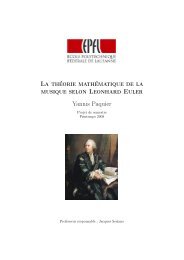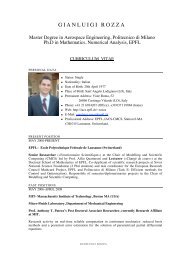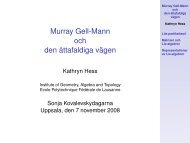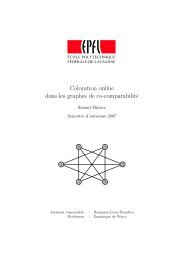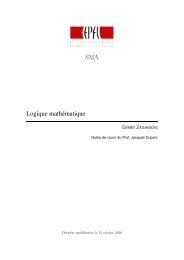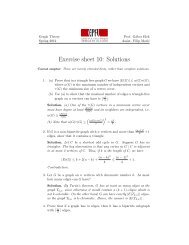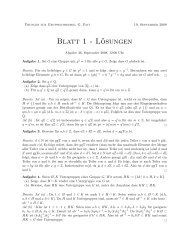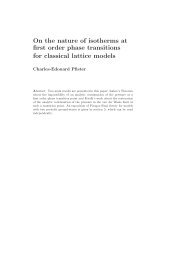Decision Models in Skiable Areas - EPFL
Decision Models in Skiable Areas - EPFL
Decision Models in Skiable Areas - EPFL
Create successful ePaper yourself
Turn your PDF publications into a flip-book with our unique Google optimized e-Paper software.
6 MODEL OF DEMAND IN A SKIABLE AREA 12<br />
• M<strong>in</strong> has a negative sign. This is also <strong>in</strong>terpretable, <strong>in</strong> the way that a low ”M<strong>in</strong>”<br />
(M<strong>in</strong>LD = m<strong>in</strong>s∈SL D ls) is more attractive.<br />
• Prot has a positive sign and this means that a lift where the skiers are protected<br />
aga<strong>in</strong>st the weather is more attractive. We have seen that this attribute co<strong>in</strong>cides<br />
with the characteristic to put off the skis. This means that the protection aga<strong>in</strong>st<br />
the weather is more appreciated by the skiers than the disadvantage to put off the<br />
skis.<br />
• Seats has also a positive sign. A lift where the skiers can sit down is more<br />
attractive than one without the possibility to sit down.<br />
The sign of the coefficient Maxmax can not be <strong>in</strong>terpreted, because the positive sign of<br />
the attribute Max tells us that the skiers like the high-level ski slopes. So it could also<br />
be suspected that the coefficient Maxmax has a positive sign. Or, at least that the both<br />
coefficients have the same sign.<br />
Because the two attributes Manmax D O and P rotD has to be supposed random<br />
variables and because the sign of the coefficient Maxmax can not be <strong>in</strong>terpreted, it is<br />
likely that the Basic Model can be improved. The fact that the attributes Manmax D O<br />
and P rotD are random variables leads to the first approach, the time dependence of<br />
the coefficients M<strong>in</strong>max and Prot. This is described <strong>in</strong> section 6.1.3. The fact, that the<br />
sign of the coefficient Maxmax can not be <strong>in</strong>terpreted <strong>in</strong> an <strong>in</strong>tuitive way is, as already<br />
mentioned, the motivation of the second approach <strong>in</strong> section 6.1.4.<br />
6.1.3 First approach: Time dependence of ”M<strong>in</strong>max” and ”Prot”<br />
View that the coefficients ”M<strong>in</strong>max” and ”Prot” are random variables, a time dependence<br />
of this coefficients is proved. It is assumed that the coefficient <strong>in</strong> the determ<strong>in</strong>istic<br />
term correspond<strong>in</strong>g to M<strong>in</strong>max is<br />
�<br />
T ime<br />
M<strong>in</strong>max ·<br />
t0<br />
� λmo<br />
∀ T ime < t0<br />
where the time is measured <strong>in</strong> m<strong>in</strong>utes and t0 chosen to be 720, what correspond to<br />
noon (start<strong>in</strong>g at midnight). In the afternoon, we have<br />
�<br />
T ime<br />
M<strong>in</strong>max ·<br />
t0<br />
� λan<br />
∀ T ime ≥ t0<br />
An example of this function depend<strong>in</strong>g of the time is illustrated <strong>in</strong> Figure 3 where<br />
M<strong>in</strong>max is set to 1, λmo and λan to -1.72 and 0.58 respectively. The parameters λmo<br />
and λan can also be estimated by Biogeme. The same approach is done <strong>in</strong> the case of<br />
the coefficient ”Prot”. This leads to two coefficients µmo and µan. All together, four<br />
additional parameters has to be estimated <strong>in</strong> this model.<br />
The result of this estimation is illustrated <strong>in</strong> Figure 4. It can be observed that µmo<br />
is not significant and it reaches the lower bound of −5 which is very unrealistic. The<br />
attribute σan is also not significant. The failure of the t-test means that the hypotheses<br />
of time dependence of the two attributes has to be rejected. You can also remark that<br />
the sign of Maxmax is still negative. This is the reason, why we leave the strategy to<br />
ameliorate the attributes M<strong>in</strong>max and Prot. We rather look to change the model that<br />
Maxmax becomes a positive number (Or at least that Max and Maxmax have the same<br />
sign).<br />
(27)<br />
(28)



